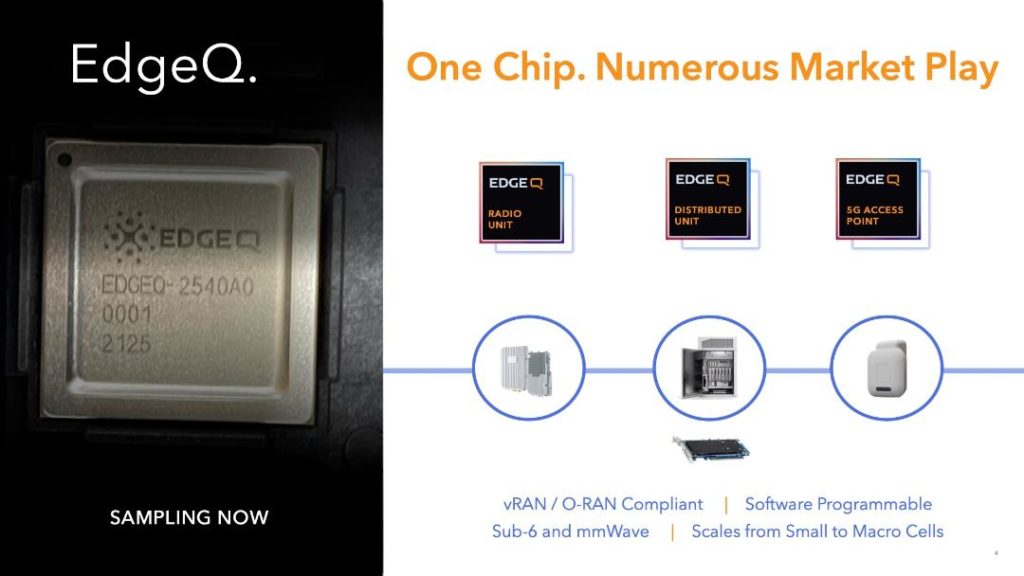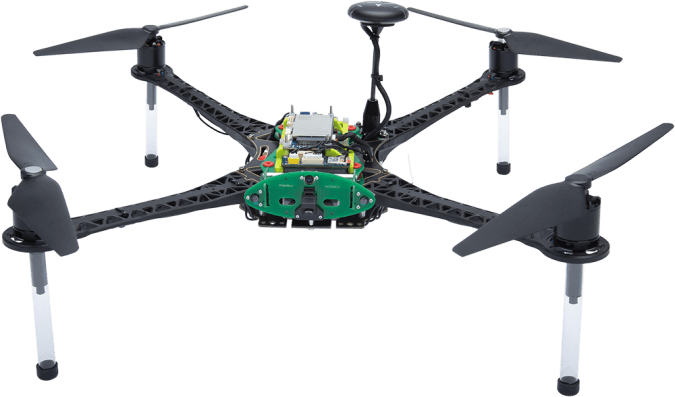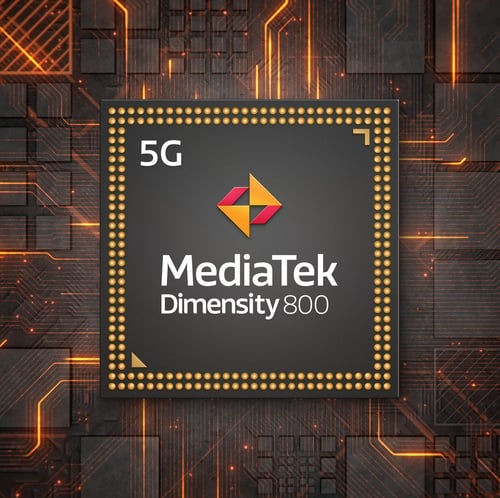5G silicon
MediaTek overtakes Qualcomm in 5G smartphone chip market
According to new figures from Omdia’s Smartphone Model Market Tracker, shipments of 5G smartphones powered by Taiwan based MediaTek reached 53 million in the first three months of the year, representing an impressive 53% uptick on Q1 2023. Shipments of smartphones with Qualcomm’s Snapdragon inside were comparatively flat, inching up to 48.3 million from 47.2 million.
MediaTek’s market share in 5G smartphones rose to 29.2% in 1Q24, up from 22.8% in 1Q23, while Qualcomm Snapdragon’s share decreased from 31.2% to 26.5% over the same period.
As a result, MediaTek’s market share in the 5G smartphone chipset market increased to 29.2% from 22.8%, while Qualcomm’s fell to 26.5% from 31.2%. Apple is third, while a Samsung owned Exynos, Huawei-owned HiSilicon’s Kirin, Google Tensor and Shanghai-based Unisoc make up the rest (see chart below).
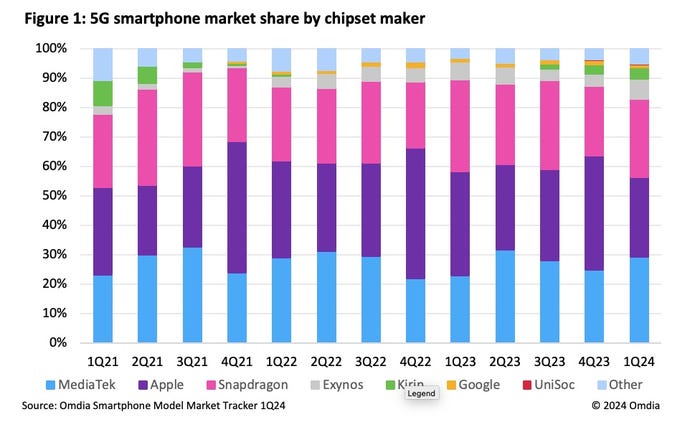
Notes:
- It’s not clear whether Omdia includes both processors and 5G modem chip sets in their statistics.
- Apple uses in-house processors for its iPhones, but it still relies on Qualcomm for the 5G modem chips.
- Both MediaTek and Qualcomm sell SoC’s which include both a 4G/5G modem and an ARM processor.
……………………………………………………………………………………………………………………………
According to Omdia, Q1 shipments of 5G smartphones below $250 surged by 62% year-on-year to 62.8 million. This favors MediaTek as the preferred choice for this segment. Furthermore, in June, Omdia also reported in booming demand for sub-$150 phones, with shipments in this category growing to 120 million in the first quarter, up from 90 million a year earlier.
“The smartphone chipset industry is primarily shaped by two major trends: the widespread adoption of 5G and the expanding low-end segment. As 5G technology becomes more affordable and is integrated into smartphones priced below $250, MediaTek stands to benefit the most,” explained Aaron West, senior analyst in Omdia’s smartphone group.
The premium end of the market, where prices start at $600, is also growing – albeit not as rapidly. According to Omdia, shipments increased to 73 million from 70 million, driven by the launch of Samsung’s Galaxy S24 series, and the iPhone 15 Pro Max.
The popularity of premium devices should help Qualcomm come roaring back – it has spent much of this year promoting the on-device AI capabilities of its latest Snapdragon chipset, features that will be incorporated first and foremost into pricier handsets.
“On-device AI capabilities are becoming increasingly important to smartphone OEMs, with Snapdragon emerging as a key innovator and preferred choice for premium devices,” West said.
……………………………………………………………………………………………………………………………
Other Voices:
- According to Markets and Markets, the global 5G chipsets market size is estimated to be USD 36.29 billion in 2023 and is projected to reach USD 81.03 billion by 2028 at a CAGR of 17.4%.
- Grandview Markets says the global 5G chipset market size was estimated at USD 39.32 billion in 2023 and is expected to grow at a CAGR of 20.7% from 2024 to 2030.
Illustrations:


References:
https://www.lightreading.com/5g/mediatek-outgrowing-qualcomm-snapdragon-in-the-5g-smartphone-market-omdia
https://www.telecoms.com/mobile-devices/rise-of-cheaper-5g-phones-lifts-mediatek-above-qualcomm
https://www.marketsandmarkets.com/Market-Reports/5g-chipset-market-150390562.html
https://www.grandviewresearch.com/industry-analysis/5g-chipset-market
GSA: More 5G SA devices, but commercial 5G SA deployments lag
Global 5G Market Snapshot; Dell’Oro and GSA Updates on 5G SA networks and devices
Mediatek Dimensity 6000 series with lower power consumption for affordable 5G devices
Synopsys 5G SoC enhances 5G development with new RF design flow for TSMC N6RF process
RFICs (Radio Frequency Integrated Circuits) for wireless data transmission systems, such as transceivers and RF front-end components, are becoming more complex based on the demands of our connected world. These next-generation wireless systems are expected to deliver higher bandwidth, lower latency and better coverage across more connected devices. To ensure their RFICs can meet these requirements, designers must be able to accurately measure parameters such as RF performance, spectrum, wavelength and bandwidth.
To address increasingly complex RFIC design requirements, Synopsys, Inc. today announced a new RF design flow developed with Ansys and Keysight for the TSMC N6RF process, the most advanced RF CMOS technology that offers significant performance and power efficiency boosts. The flow helps mutual customers achieve power and performance optimizations for 5G chips while also accelerating design productivity for faster time-to-market.
“Our latest collaboration with Synopsys addresses the challenges of next-generation wireless systems, enabling designers to deliver greater connectivity, higher bandwidth, lower latency and better coverage for our increasingly connected world,” said Suk Lee, vice president of the Design Infrastructure Management Division at TSMC. “With high-quality, tightly integrated solutions from Synopsys as well as Ansys and Keysight, the new TSMC RF Design Reference Flow for the TSMC N6RF process provides a modern, open approach that enhances productivity for developing these complex ICs.”
The new RF design reference flow improves design turnaround time with industry-leading circuit simulation and layout productivity performance, as well as accurate electromagnetic (EM) modeling and electromigration/IR-drop (EMIR) analysis. The flow includes the Synopsys Custom Compiler™ design and layout product, Synopsys PrimeSim™ circuit simulation product, Synopsys StarRC™ parasitic extraction signoff product and Synopsys IC Validator™ physical verification product; Ansys VeloceRF™ inductive component and transmission line synthesis product, Ansys RaptorX™ and Ansys RaptorH™, the advanced nanometer electromagnetic (EM) analysis products, and Ansys Totem-SC®; and Keysight’s PathWave RFPro for EM simulation.
RF applications include:
- Wireless communications, e.g., 5G, cell phones, WiFi, Bluetooth
- Radio broadcasting, e.g., AM/FM radio
- RF remote control, e.g., garage door opener, drones
- Remote sensing, e.g., weather or surveillance radar
- Satellite navigation, e.g., GPS, Galileo, Glonass, Beidou
- Imaging, e.g., body scanners for airport security
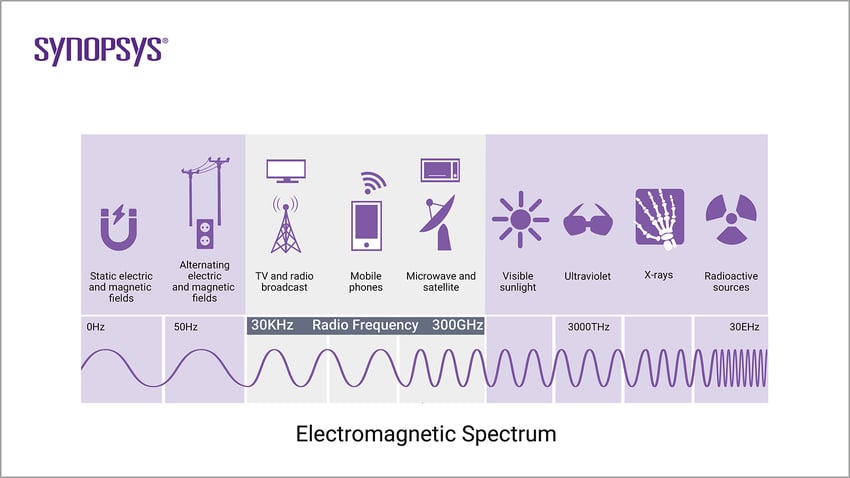
“To enable key differentiating advantages for 5G designs, Synopsys continues to deliver robust RF design solutions that integrate electromagnetic synthesis, extraction, design, layout, signoff technologies and simulation workflows,” said Aveek Sarkar, vice president of engineering at Synopsys. “Because of our deep collaboration with TSMC and strong relationships with Ansys and Keysight, our customers can now take advantage of the advanced features within the Synopsys Custom Design Family, using TSMC’s advanced N6RF technology for 5G applications, to improve productivity and achieve silicon success.”
“RF design customers benefit significantly from the interoperability between Synopsys Custom Compiler and PathWave RFPro in the TSMC reference flow,” said Niels Fache, vice president and general manager of PathWave Software Solutions at Keysight Technologies. “Shifting electromagnetic co-simulation left in the design process enables RF circuit designers to optimize for the parasitic effects in advanced chips and multi-technology modules for 5G and WiFi 6/6E applications. This saves days and sometimes weeks in the simulation workflow, while reducing the risk of costly re-spins in the product development cycle. Our partnership with Synopsys and TSMC gives RF customers the design tools and advanced process technology they need to ensure high performance with first-pass success.”
“Ansys is excited to collaborate with Synopsys and TSMC on an advanced reference flow for RFIC designs,” said Yorgos Koutsoyannopoulos, vice president of research and development at Ansys. “Significant complexity driven by the growing need for 5G and 6G designs, along with advanced process effects at nanometer nodes, pose a big challenge to RFIC designers. Accurately modeling advanced process effects in EM and EMIR analyses is critical to creating first-pass silicon operating from DC to tens of GHz. Working seamlessly with the Synopsys Custom Complier platform, Ansys tools such as VeloceRF, RaptorX, Exalto and Totem-SC have the highest capacity to handle the most challenging designs as well as the ability to model all advanced process effects. They provide an intuitive and easy-to-use flow for the design, optimization and verification of RF design blocks.”
Synopsys, Inc. is the Silicon to Software™ partner for innovative companies developing the electronic products and software applications we rely on every day. As an S&P 500 company, Synopsys has a long history of being a global leader in electronic design automation (EDA) and semiconductor IP and offers the industry’s broadest portfolio of application security testing tools and services. Whether you’re a system-on-chip (SoC) designer creating advanced semiconductors, or a software developer writing more secure, high-quality code, Synopsys has the solutions needed to deliver innovative products. Learn more at https://www.synopsys.com.
References:
https://www.synopsys.com/glossary/what-is-rf-circuit-design.html
Acumen Research: 5G Chipset Market to Hit $145,288M by 2030 with CAGR=66.3%
According to a new report by Acumen Research, the Global 5G Chipset Market totaled for US$ 1,612 Million in 2021 and is expected to reach US$ 145,288 Million by 2030 with a considerable CAGR of 66.3% during the forecast timeframe of 2022 to 2030.
With the rising reliance on the virtualized environment during the COVID-19 epidemic, the necessity for sophisticated 5G infrastructure became critical. The increased regularity with which organizational processes are migrating to the cloud and other virtual environments has encouraged expenditures in robust interconnection platforms. This trend is expected to continue in the aftermath of the global epidemic crisis, as firms and businesses are unlikely to return to their traditional modes of operation. Furthermore, as business needs become more diverse, organizations are striving to harmonize them, necessitating the need for 5G infrastructure. As a result, rapid growth in the global number of connected devices and vehicles, as well as increased digitalization and smart city programs, are some of the major factors expected to drive the global 5G technology market. However, based on this ongoing trend, researchers project that the market will grow by more than 50x in terms of value.
However, rising demand for high-speed data transmission, mobile broadband technology, and data and information analysis is propelling 5G cellular technology forward. As a result, growing demand for high-speed internet and 5G cellular technologies for a variety of applications, including automated vehicles, distance learning, multiuser gaming, live streaming, videoconferencing, telemedicine, and virtual reality, is expected to propel the 5G chipset market forward. A 5G chipset component is required for 5G-enabled mobile phones, computers, gateways, and telephony base stations. This 5G chipset module enables these devices’ users to connect to next-generation connections and enjoy a more improved experience.

Global 5G Chipset Market Growth Aspects
One of the key factors driving the market is the increasing need for high-speed internet and extensive network availability for multiuser videogames, video broadcasts, and file-sharing. Furthermore, major market players are heavily investing in R&D operations to develop cost-effective technology networks and virtual network configuration management, which are expected to drive 5G chipset market growth. In addition, many businesses use internet of things (IoT) devices and 5G advanced technologies to monitor machine performance in real-time, reducing overall idle time and improving operational efficiency. This, combined with the growing popularity of the internet of things (IoT) in the development of smart cities, infrastructure, and grid projects around the world, is propelling the market growth.
Furthermore, limited global 5G coverage and accessibility of 5G networks in specific areas can raise the cost of establishing tower stations and limit the adoption of 5G chipsets, which is expected to limit market revenue growth to some extent over the forecast period. Besides that, the incorporation of 5G chipsets in production lines and workflows to speed up production and boost Industrial revolution 4.0 has substantially increased demand for 5G chipsets, which is expected to drive 5G chipset market revenue growth during the forecast period.
Drivers:
- Increasing cellular Internet of Things (IoT) connections
- Rising demand for high-speed internet and extensive network coverage
- Growth in mobile data traffic
- Demand for connected devices and vehicles is on the rise
Restraints:
- Concerns about data security and information privacy
- High initial cost for chipsets
Opportunity:
- Increased use of automation in the workplace and on the production line in the industry
- Growing Smart city projects in developing economies
Report Coverage:
| Market | 5G Chipset Market |
| Market Size 2021 | US$ 1,612 Million |
| Market Forecast 2030 | US$ 145,288 Million |
| CAGR | 66.3% During 2022 – 2030 |
| Analysis Period | 2018 – 2030 |
| Base Year | 2021 |
| Forecast Data | 2022 – 2030 |
| Segments Covered | By Frequency Type, By Type, By Process Node, By End Use, By Industry Vertical And By Geography |
| Regional Scope | North America, Europe, Asia Pacific, Latin America, and Middle East & Africa |
| Key Companies Profiled | Qualcomm Technologies, Inc., Broadcom, Intel Corporation, Nokia Corporation, Samsung Electronics Co., Ltd., Mediatek Inc., Anokiwave, Xilinx Inc., Huawei Technologies Co., Ltd., Unisoc Communications, Inc., Qorvo, and Infineon Technologies AG. |
| Report Coverage | Market Trends, Drivers, Restraints, Competitive Analysis, Player Profiling, Regulation Analysis |
| Customization Scope | 10 hrs of free customization and expert consultation |
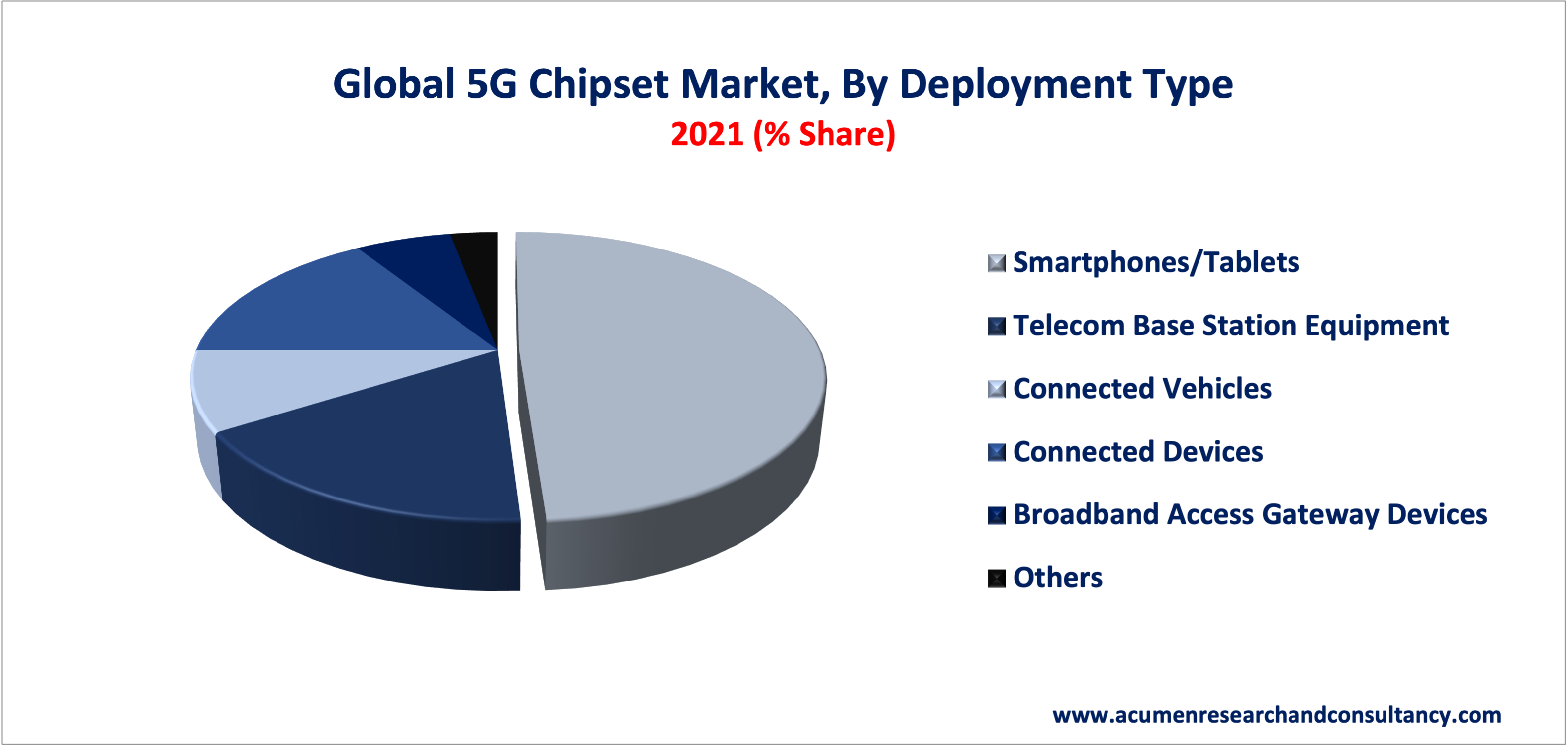 Regional Overview
Regional Overview
North America, Europe, Asia-Pacific, Latin America, and the Middle East & Africa are the regional classification of the global 5G chipset market. The North America market is expected to account for the largest revenue share over the forecast period due to the increasing adoption of innovative technologies that require high-speed Internet, such as IoT connectivity or machine to machine in different industry sectors. Furthermore, the large presence of major market players in the region’s countries, such as Qualcomm Incorporated, Intel Corporation, MediaTek Inc, and others, is expected to drive revenue growth in the region throughout the projection period. As regulators clear the way for rapidly expanding next-generation services, the United States is expected to be the first in the world to deploy 5G technology, wireless applications, and infrastructures. For example, the US administration announced $400 million in projects to conduct research on 5G wireless connections in July 2016. Furthermore, the Government of Canada is strongly committed to enhancing involvement in next-generation communication networks and 5G technologies by creating an innovation environment that promotes ICT growth.
To receive personalized service, please share your research needs here@ https://www.acumenresearchandconsulting.com/request-customization/2921
Market Segmentation:
The global 5G chipset market has been segmented by Acumen Research and Consulting based on frequency type, chipset type, process node, deployment type, and industry vertical. Based on the frequency type, the market is divided into sub-6GHz, mmWave, and sub-6GHz + mmWave. Based on chipset type, the market split into modem, and RFIC. Based on process node, the market is classified into 7 nm, 10 nm, and others. Based on deployment type, the market is categorized into smartphones/tablets, telecom base station equipment, connected vehicles, connected devices, broadband access gateway devices, and others. Based on industry vertical, the market is segmented into manufacturing, energy & utilities, media & entertainment, IT & telecom, transportation & logistics, healthcare, and others.
Major Players:
Some key players covered global in the 5G chipset industry are Qualcomm Technologies, Inc., Broadcom, Intel Corporation, Nokia Corporation, Samsung Electronics Co., Ltd., Mediatek Inc., Anokiwave, Xilinx Inc., Huawei Technologies Co., Ltd., Unisoc Communications, Inc., Qorvo, and Infineon Technologies AG [1.].
……………………………………………………………………………………………………………………………………………………………………………………………………………………………………………….
Note 1. It’s this author’s opinion that there are only two players in the merchant market for 5G baseband silicon in 5G endpoint devices- Qualcomm and MediaTek. Samsung and Huawei make custom 5G silicon for use in their own 5G phones and base stations, but they do not sell them on the merchant market. A player not mentioned is EdgeQ which offers a “5G base station on a chip” for 5G network equipment (small cells and base stations). Qorvo makes 5G power amplifiers and ultra low noise amplifiers along with other RF products
……………………………………………………………………………………………………………………………………………………………………………………………………………………………………………….
Request for a sample of this premium research report @ https://www.acumenresearchandconsulting.com/request-sample/2921
About Acumen:
Acumen Research and Consulting is a global provider of market intelligence and consulting services to information technology, investment, telecommunication, manufacturing, and consumer technology markets. ARC helps investment communities, IT professionals, and business executives to make fact based decisions on technology purchases and develop firm growth strategies to sustain market competition. With the team size of 100+ Analysts and collective industry experience of more than 200 years, Acumen Research and Consulting assures to deliver a combination of industry knowledge along with global and country level expertise.
Contact Us:
Mr. Richard Johnson
Acumen Research and Consulting
USA: +1 407 9154157
India: +91 8983225533
E-mail: [email protected]
References:
https://www.acumenresearchandconsulting.com/5g-chipset-market
https://www.qorvo.com/innovation/5g
Data Bridge: 5G Chipset Market Expected to Reach $2,519.78 Billion by 2029 with CAGR of 49.02%
Data Bridge Market Research has released a new report, “5G Chipset Market Report-Development Trends, Threats, Opportunities and Competitive Landscape” focusing on primary and secondary drivers, market share, market size, sales volume, leading segments and geographical analysis of 5G silicon.
The 5G chipset market will exhibit a CAGR of 49.02% for the forecast period of 2022-2029 and is likely to reach the $2,519.78 billion by 2029. The rise in the cellular IoT (internet of things) connections will influence the growth rate of the 5G chipset market. The upsurge in the demand for high speed internet and broad network coverage is a key element driving market expansion. The 5G chipset market is also being driven by factors such as rising mobile data traffic and increasing need for smart technologies.
Furthermore, technological advancements and increase in the popularity of 5G-enabled smartphones will enhance the growth rate of 5G chipset market. Also, the upsurge in the demand for ultra-reliable and low-latency data networks capable of providing seamless connectivity will act as a major factor influencing the growth of 5G chipset market.

Asia-Pacific dominates the 5G chipset market and will continue to flourish its trend of dominance due to the growing level of investment in research and development, increase in developments in emerging 5G enabled smartphones and base stations supporting 5G frequencies in this region. North America is expected to grow during the forecast period of 2022-2029 due to the rapidly rising automotive and consumer electronics sectors in this region.
Top Players Analyzed in the Report:
- Analog Devices
- Texas Instruments
- NXP Semiconductors
- Broadcom
- Huawei Technologies
- Qualcomm Technologies
- SAMSUNG
- Xilinx
- Nokia
- Intel Corporation
- Infineon Technologies
- IBM
- Renesas Electronics Corporation
- Qorvo, Marvell
- Unisoc (Shanghai) Technologies
- Skyworks Solutions
- Anokiwave
Key Market Segmentation:
- On the basis of frequency type, the 5G Chipset Market has been segmented as sub-6Hz, between 26 and 39 GHz and above 39 GHz.
- Based on processing node type, the 5G chipset market has been segmented into 7 nm, 10 nm and others.
- Global 5G chipset market on the basis of chipset type has been segmented as application-specific integrated circuit (ASIC), radio frequency integrated circuit (RFIC), millimeter wave integrated circuit (mmWave IC) and cellular integrated circuit (cellular IC).
- Based on deployment type, the 5G chipset market has been segmented into telecom base station equipment, smartphones/tablets, connected vehicles, connected devices, broadband access gateway and others. Apart from telecom base station equipment, all other categories can be further sub-segmented into single-mode and multi-mode. Single-mode can be divided into standalone and non-standalone.
- Based on end user, the 5G chipset market has been segmented as energy and utilities, manufacturing, IT and telecom, media and entertainment, transportation and logistics, healthcare and others.
Recent Developments:
In January 2021, MediaTek had launched chipset to power 5G smartphones. They launched new Dimensity 1200 and Dimensity 1100 5G smartphone chipset along with the developed AI, camera and multimedia properties for superior 5G experience. Both chipsets support every generation of connectivity, from 2G to 5G, as well as the most up-to-date connectivity capabilities.
In June 2021, start-up EdgeQ had launched industry’s first 5G Chipset-as-a-Services for 5G wireless infrastructure market. Customers can configure 5G and AI services with EdgeQ’s innovative software defined 5G base station-on-a-chip technology, which changes the industry to a service-oriented, pay-as-you-go structure.
In May 2021, Qualcomm had launched 5G modem elevated for industrial IoT. The Qualcomm 315 5G IoT modem enables global 5G NR sub-6GHz bands and functions in stand-alone (SA) alone mode, with the flexibility to transition to LTE as required. It can be operated over private or public 5G networks, using network slicing or in isolation.
References:
https://www.databridgemarketresearch.com/reports/global-5g-chipset-market
https://www.databridgemarketresearch.com/checkout/buy/singleuser/global-5g-chipset-market
Architecting a Software-Defined Base Station-on-a-Chip for 5G Wireless Infrastructure
by Vinay Ravuri, CEO and Founder of EdgeQ Inc. (edited for clarity by Alan J Weissberger)
Introduction:
EdgeQ emerged from stealth mode in late 2020 as one of the very few semiconductor companies addressing 5G wireless infrastructure with a clean slate design. We wanted to approach 5G as a platform (chip hardware + RAN software) that allows fluidity and scale as customers migrate through new spectrum, new ITU-R standards/ 3GPP specifications, and new endpoints. Our vision is to reconstitute the wireless infrastructure in a manner that is intelligent, agile, and cloud-native.
Removing the Friction Points in 5G:
The success of any silicon design can be premised on three fundamentals: Flexibility, Power, and Cost. 5G is no exception. The industry’s challenge with 5G design can be parsed as follows:
- Flexibility — Very few merchant silicon suppliers can provide a fully production readied L1. With 5G, there is an added complexity where the L1 needs to be adaptive and programmable to the multitude of workloads and use cases.
- Power — At EdgeQ, we are guided by the 50:50 principle. 50% of a base station TCO is related to power. 50% of the power is related to baseband processing. Just changing the power profile of the baseband profoundly impacts the total system.
- Cost – Cost will be a byproduct of the above two. With the anticipated bandwidth and explosion of new end point connections, linear scaling of OpEx and CapEx costs is not sustainable.
Design for Flexibility and Openness: 5G with a Customizable, Deployable PHY:
EdgeQ’s approach is to provide a RISC-V based SoC with a production-grade RAN that is fully customizable via C/C++. This would enable the market with the ability to differentiate 5G at the PHY level. This contrasts with traditional solutions which offer a reference stack for 5G RAN algorithms.
Hardening of the PHY layer is both an intensive and extensive process that typically requires 2-3 years of knowledgeable expertise. The level of integration and development is where most companies struggle or fail. EdgeQ offers an open, production-readied PHY out of the box.
By softwardizing the RAN, we can provide a chip that is dynamically programmable to any of the ORAN splits. New 3GPP standards (like REL16, REL 17, REL 18 upgrade) can be rolled out over-the-air. New features (like URLLC or massive MIMO) can be deployed on the fly. Multiple protocols can be simultaneously instantiated and coherently parallelized. Whether it is 4G, 5G, or AI, each network protocol can be turned on-or-off in the field.
EdgeQ’s “5G Base Station-on-a-Chip” is based on an unique hybrid architecture where a RISC-V compute complex is responsible for baseband processing. Our thesis is to enable the ecosystem access to open-source tools to develop on top of our extended RISC-V instruction sets. For the first time in communications history, the market can capitalize on GNU tool chains (compilers, tracers, debuggers, JTAG ….) for wireless communications.
Design for Low Power: Aggressive 5G Power Management for Wireless Infrastructure:
When EdgeQ instrumented its SoC, all the core functionalities of a base station (baseband processor, host CPU, NPU, FEC Acceleration, NIC, Data Converters, Timing Sync, and Machine Learning) are condensed into a single silicon. Depending on the uploaded PHY firmware, the EdgeQ SoC can be function as a small cell (gNB), or a Radio Unit (RU), or Distributed Unit (DU) – please see illustration below.
This highly integrative approach is particularly meaningful for all-in-one access points, where customers may want to converge all the O-RAN splits onto a single chip, and yet run the entire system over Power over Ethernet (PoE). Equally, with such a low power profile, customers can contemplate new macro base station topologies where densely packed PCIe cards within distributed Units (DU) can be dynamically swapped or “spun up” to scale with real-time performance and functional needs.
Design for Cost: Flexibility + Low Power:
One vector to reducing the overall system TCO is by substantially reducing the power envelop. Through integration, advanced power management techniques, and unique design, all L1 baseband processing functions at EdgeQ run in the low teens, thereby significantly reducing a customer’s TCO.
Secondarily, by creating a fully programmable 5G Base Station-on-a-Chip, features and performance points are now all cloud managed and activated over-the-air via a SaaS subscription model. Operators and service providers can now deploy systems at scale and effect wholesale upgrades without ripping and replacing.
As 5G becomes the “lingua franca” of connectivity, edge demands will impact the fluidity and constructs of 5G infrastructure. Foundational to any wireless infrastructure will be a programmable 5G SoC, capable of adapting to infrastructural demands with a production deployable cellular stack that is customizable. The idea is to present a scalable 5G platform in which customers and developers can leverage open-source tools and C/C++ to configure the chip.
About EdgeQ:
EdgeQ is a leading innovator creating the industry’s first 5G Base-Station-on-a-Chip. Led by seasoned executives from Qualcomm, Intel, and Broadcom who have delivered industry-transforming technologies (4G/5G, WiFi, Wimax, Artificial Intelligence, Cloud Servers) for the last few decades, EdgeQ is inventing a new paradigm in 5G wireless infrastructure.
The company’s vision is to reconstitute wireless infrastructure into a fluid, cloud-based form that would extend robust internet access and communications to remote and dense areas, as well as to the next trillion of interconnected devices.
EdgeQ is backed by world-renown investors, as well as luminary advisors Paul Jacobs, Matt Grob, Ajit Pai, and Rene Hass.
About Vinay Ravuri:

Mr. Ravuri obtained a Masters of Engineering (Major: Electrical Engineering Minor: Computer Science) from Georgia Institute of Technology in 1996, and a Bachelors of Engineering from City University of New York in 1994. He also attended Université de Montréal Deep Learning Summer School in 2016.
References:
EdgeQ Samples World’s 1st Software-Defined 5G Base Station-on-a-Chip
SoC start-up EdgeQ comes out of stealth mode with 5G/AI silicon for 5G private networks/IIoT
Picocom PC802 SoC: 1st 5G NR/LTE small cell SoC designed for Open RAN
Nokia’s new routing silicon improves IP network security and energy efficiency
Nokia today announced the launch of FP5, its fifth generation of high-performance IP routing silicon. As the new heart of Nokia’s IP service routing platforms, FP5 will enable service providers to address today’s unrelenting requirements to efficiently scale network capacity, enable new higher speed IP services, and provide unmatched protection against escalating network security threats. Building upon four generations of industry-leading network processors, Nokia is raising the bar by adding support for high density 800GE routing interfaces, a 75% reduction in power consumption and new embedded line rate, flow-based encryption capabilities. Nokia FP5-based platforms will be available starting in the first half of 2022.
When Nokia unveiled the FP4 platform four years ago it did so amid great fanfare, positioning its in-house silicon as a major advantage over its rivals. In the intervening time Nokia has made some major strategic miscalculations on its proprietary chips, especially for 5G, so this latest launch has been much more muted. However, the FP5’s decrease in power consumption is impressive.
According to an interview in Light Reading, the power consumption reduction is partly a product of more a advanced semiconductor manufacturing process and partly incorporating more stuff on a single piece of silicon, thus reducing the need for interconnects. BT has long been a fan of Nokia routing silicon and is in at the start of this latest effort.
- Nokia FP5 network processing silicon delivers a generational leap in IP network capacity and power efficiency while introducing new capabilities for protecting network traffic from security threats
- FP5 is the industry’s first high performance routing silicon delivering integrated line rate encryption for L2, L2.5 and L3 network services at speeds up to 1.6Tbps
- Nokia’s fully programmable network processor is the first to bring 800GE routing interfaces for service provider applications to market while retaining the agility to adapt to new applications
- FP5 sets a new benchmark for sustainability in IP routing with a 75% reduction in power consumption over previous generations
![]() As cloud architectures, 5G and Industry 4.0 continue to drive network transformation, service providers require mission critical IP networks to be increasingly secure, agile and sustainable. IP networks must provide guaranteed high performance and integrity in the face of growing threats from network-level attacks and security breaches. They must also be able to adapt to address unforeseen changes and to support service evolution over the lifespan of the network. In addition, IP networking equipment must become increasingly power efficient to minimize impact on the environment.
As cloud architectures, 5G and Industry 4.0 continue to drive network transformation, service providers require mission critical IP networks to be increasingly secure, agile and sustainable. IP networks must provide guaranteed high performance and integrity in the face of growing threats from network-level attacks and security breaches. They must also be able to adapt to address unforeseen changes and to support service evolution over the lifespan of the network. In addition, IP networking equipment must become increasingly power efficient to minimize impact on the environment.
With the introduction of Nokia’s fifth generation FP5 network processing silicon, Nokia says it brings a new suite of IP routing solutions to market to help service providers transform mission critical IP networks to address these new and evolving requirements.
Nokia has long been at the forefront of providing an embedded approach to IP network security. With FP4, the company transformed volumetric DDoS defense with router-based detection and mitigation. FP5 brings an additional layer of network protection with the introduction of ‘ANYsec’ – a new line rate, flow-based encryption capability integrated directly into the chipset. ANYsec supports the delivery of secure IP services including MPLS and segment routing, on-demand and at scale without impacting performance or power efficiency. Service providers can now ensure the integrity and confidentiality of all data flowing through their networks.
With FP5, Nokia brings a generational leap in router network capacity to market. Nokia service router platforms are the first to support high-density 800GE and 1.6 Tb/s clear channel routing interfaces for applications including mobile transport, IP core, peering, BNG and provider edge. New FP5-based line cards will support 14.4 Tb/s (19.2 Tb/s with Nokia’s intelligent aggregation capability.) A new series of fixed form factor 7750 Service Router-1 platforms enable the benefits of FP5 to also be realized in smaller network locations.
Nokia’s FP5 network processors drive down power consumption per bit by 75%. As FP5 is backwards compatible with FP4 and fully integrated into the latest versions of Nokia’s Service Router Operating System (SR OS), all existing features are supported from day one on the new hardware. Through this aligned hardware and software evolution strategy, Nokia delivers unmatched and sustainable investment protection to its customers.
As a fully programmable network processor, FP5 enables the agility required to evolve the network as standards and applications change. Its deterministic performance combined with rich telemetry insight ensure network operators can drive a maintainable and serviceable IP network both today and into the future.
Neil McRae, Managing Director and Chief Architect, BT, said: “BT has a long-standing relationship with Nokia, and we are pleased to see that with FP5, Nokia continues to innovate to ensure IP networks have the scale, flexibility and features to help us stay ahead of escalating demand from our residential, mobile and business customers. In particular, we are very happy to see the focus on power optimization as we grow our network, with both BT and Nokia committing to significant reduction in carbon footprint. In the past 18 months, our lives have been turned upside down, and our reliance on networks has been dramatically increased and reliability for customers is crucially important. With security being ever more important for our customers, seeing Nokia’s approach to building more security features into the platform is fantastic.”
Hiroyuki Oto, Senior Vice President and General Manager of Core Network Development Department, NTT DOCOMO, INC., said: “Our network needs to continue to evolve to meet the demands from our consumers, communities, and businesses. With Nokia’s latest generation of silicon innovation and their careful attention to ensuring investment protection with the flexibility to adapt to new requirements, we believe Nokia is delivering the right foundation to ensure IP networks can efficiently scale and transform to stay ahead of ever shifting market demands.”
Christian Gacon, Vice President, Broadband Networks, Orange France, said: “We have had a long relationship with Nokia from the very first silicon processor release. As our network continues to evolve to meet the demands of our customers, innovations such as Nokia’s FP5 silicon will enable us to balance capacity, maintainability and security to deliver the best customer experience. Introducing this exciting innovation into existing platforms will ensure that we can gracefully evolve our networks as we look to manage both planned and unexpected demands in a sustainable way.”
Ray Mota, CEO and Principal Analyst, ACG Research, said: “Nokia does it again and shows its understanding and commitment to service providers, which has been key in its #1 momentum gain in the overall $12 billion service provider market. With the introduction of its fifth generation FP5 routing silicon, we believe Nokia is well-positioned to continue as a vendor of choice for service providers seeking to evolve their IP networks to become more agile, efficient, and secure all the while providing investment protection.”
Federico Guillén, President of Network Infrastructure, Nokia, said: “Of all the things that are surprising about human beings, perhaps the most surprising is our ability to be surprised. Our customers require their networks to be robust, agile and adaptable enough to handle everything life throws at them – from disruptive security threats to a global pandemic. FP5 is a significant step forward in performance, security and efficiency and – in combination with our software excellence and investment in network automation and tools – it opens the next chapter in Nokia’s long-standing leadership in IP networking and IP silicon innovation.”
“This is the industry’s most advanced network-processing silicon for service provider IP networks,” Heidi Adams, VP of IP and optical network marketing at Nokia, said in a phone interview.
Resources:
- Webpage: Nokia FP5
- Video: Master the unexpected with Nokia’s new FP5 silicon
- eBook: Master the unexpected with Nokia FP5
- App Note: Nokia FP5 silicon innovation
- Webpage: IP Network security
- Media Library: Nokia FP5 image
References:
EdgeQ Samples World’s 1st Software-Defined 5G Base Station-on-a-Chip
EdgeQ Inc, a leader in 5G wireless infrastructure, today announced sampling of its revolutionary 5G Base Station-on-a-Chip to Tier 1 customers deploying next-generation wireless edge networks for the enterprise, telco and cloud markets. EdgeQ is sampling the full suite solution to customers developing enterprise-grade 5G access points, Open-Radio Access Network (O-RAN) based Radio Unit (RU) and Distributed Unit (DU).
Successful deployment of Radio Access Networks (RAN) requires the availability and access to production-ready Physical Layer (PHY) hardware and software that governs all the essential protocols and features of 4G/5G. Traditional merchant silicon vendors offer the PHY as a reference software, placing the development burden on customers to invest years of effort to operationalize into production. By abstracting this friction with a total platform solution including a production-readied 5G PHY software, EdgeQ says that frees customers from the substantial investments, resources and time typically associated with productizing the 4G/5G PHY layer.

“Traditional market approaches offer baseband processing hardware and PHY software as separate topics, where the burden of proof rests on customers to fully productize and enable. EdgeQ has the ability and completeness to accelerate the market with a production-grade RAN stack that is also customizable and programmable,” said Chris DePuy, Technology Analyst at 650 Group. “The linchpin to lowering the 5G entry barrier is enabling operators and organizations with a total turnkey solution that is at the same time agile, flexible, and complete.”
Three years in the making, EdgeQ has been collaborating with market-leading wireless infrastructure customers to architect a highly optimized 5G baseband, networking, compute and AI inference system-on-a-chip. By coupling a highly integrated silicon with a production-ready 5G PHY software, EdgeQ uniquely enables a frictionless operating model where customers can deploy all key functionalities and critical algorithms of the radio access network such as beamforming, channel estimation, massive MIMO and interference cancellation out of the box.
For customers looking to engineer value-adds into their 5G RAN designs, the EdgeQ PHY layer is completely programmable and extensible. Customers can leverage an extendable nFAPI interface to add their custom extensions for 5G services to target the broad variety of 5G applications spanning Industry 4.0 to campus networks and fixed wireless to telco-grade macro cells. As an industry first, the EdgeQ 5G platform holistically addresses the pain point of deploying 5G PHY and MAC software layers, but with an open framework that enables a rich ecosystem of L2/L3 software partners.
“Since day one, EdgeQ has been relentless about redefining the consumption and deployment model of 5G with its RISC-V based open architecture that converges connectivity, networking, and compute. How we elegantly club the hardware, the deployable RAN software, and an innovative chipset-as-a-service business model all together is what crystallizes the vision in a disruptively compelling way,” said Vinay Ravuri, CEO and Founder, EdgeQ. “Our sampling announcement today signifies that all this is a market reality.”
About EdgeQ
EdgeQ is a leading innovator in 5G systems-on-a-chip. The company is headquartered in Santa Clara, CA, with offices in San Diego, CA and Bangalore, India. Led by executives from Qualcomm, Intel, and Broadcom, EdgeQ is pioneering a converged connectivity and AI that is fully software-customizable and programmable. The company is backed by leading investors, including Threshold Ventures, Fusion Fund and AME Cloud Ventures, among others.
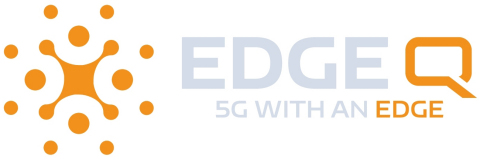
To learn more about EdgeQ, visit www.edgeq.io.
References:
Qualcomm unveils 5G and AI-Enabled Drone Platform
Qualcomm Technologies, Inc. is showing off what is says is the world’s first drone platform and reference design to offer both 5G and AI-capabilities, the Qualcomm Flight RB5 5G Platform.
The company says the drone reference design helps accelerate development for commercial, enterprise, and industrial drones, and unleashes innovative possibilities for industries looking to adopt drone solutions and realize the benefits of the intelligent edge. 5G connectivity — including mmWave and sub-6 GHz bands — and WiFi 6. The chip-maker says the networking tech can help support drone-to-drone communications and drone swarms. Both use cases are being explored across industries, from delivering and transporting goods to aerial light displays to military warfare.
The drone model below is includes an embedded Qualcomm® QRB5165 processor and a Qualcomm Spectra 480 Image Signal Processor that can capture 200 megapixel photos and 8K video at 30 FPS. In addition, the drone can record in 4K at 120 FPS with support for HDR.

Image Credit: Qualcomm
………………………………………………………………………………………………..
The company says that the Qualcomm Flight RB5 5G Platform brings cutting-edge capabilities to the drone industry by condensing multiple complex technologies into one tightly integrated drone system to support evolving applications and new use cases in sectors including film and entertainment, security and emergency response, delivery, defense, inspection, and mapping.
At its core, the Flight RB5 5G platform uses the QRB5165 processor and Kryo 585 CPU and Adreno 650 GPU, based on the Snapdragon 865 CPU. The AI enhancements come by way of the Hexagon Tensor Accelerator in the Hexagon 698 DSP. Third-parties that use the platform will also get access to a trio of software development kits for neural processing, computer vision and multimedia applications.
The Qualcomm Flight RB5 5G Platform’s high-performance and heterogeneous computing at ultra-low power consumption provides power efficient inferencing at the edge for AI and Machine Learning (ML) enabling fully autonomous drones. Breakthrough camera capabilities deliver premium image capabilities and performance. With 5G and Wi-Fi 6 connectivity, this platform enhances critical flying abilities beyond visual line-of-sight (BVLOS) to support safer, more reliable flight. In addition, safety controls alone can no longer assure industrial and commercial drone safety, especially when scaling to Beyond Visual Line of Sight operations. The Qualcomm Flight RB5 5G Platform is equipped with a Qualcomm® Secure Processing Unit to support modern drone demands for cybersecurity protections as a key enabler of data-protection and safety requirements.
Qualcomm Technologies is working with Verizon to complete network testing of the Qualcomm Flight RB5 5G Platform for the Verizon 5G network, and expects the platform, which is 5G mmWave capable, will be offered via the Verizon Thingspace Marketplace.
The Qualcomm Flight RB5 5G drone reference design is available for pre-sale now through ModalAI. The Qualcomm Flight RB5 5G development kit is expected to be available in Q4 of 2021. For more information on the platform, including technical features, please visit the product details page here.
Backgrounder:
Qualcomm first got involved in drones in 2015, then ventured into robotics in 2019. Last year it combined the two technologies in its RB5 platform. Chad Sweet’s ModalAI, which in 2018 spun out of Qualcomm, will manufacture and distribute the drone platform, and says the first development kits will ship in the last three months of this year.
Qualcomm, which already commands a huge lead in the 4G/5G smartphone industry, is hoping its Snapdragon chipsets can be the silicon that pushes 5G into a wider range of other devices. The company has made a series of drone platforms since its first, Qualcomm Flight, in 2018.
…………………………………………………………………………………………
Global carriers and IoT ecosystem leaders showcase validation and support for Qualcomm Technologies latest drone solution:
Asia Pacific Telecom
“As the leader in innovative telecom services in Taiwan, Asia Pacific Telecom Co., Ltd (APT) is excited to work with one of our most important strategic collaborators, Qualcomm Technologies on the support of 5G and AI-enabled drones. APT provides 5G and application integration services to advance the performance of robots and drones in different perspectives. We truly believe that 5G capabilities built into the platform will enable new autonomous drone experiences,” said Mr. Shang-Chen Kao, chief technology officer, network and technology center, Asia Pacific Telecom.
AT&T
“Many of the anticipated benefits of drones will be further accelerated and strengthened with 5G, including delivery, inspections, and search and rescue, which will require a highly secure and reliable connection. We are excited to see Qualcomm Technologies continue to innovate with their latest announcement on a platform for 5G drones,” said Kevin Hetrick, vice-president, access construction and engineering, AT&T.
China Unicom
“The 5G-enabled digital era has brought wider boundaries for every industry and China Unicom is committed to pushing the boundaries of the traditional communications ecosystem and working together with the industrial chain to realize mutual complementarity. As one of our important collaborators, Qualcomm Technologies has been working with China Unicom to drive integration of 5G and IoT into vertical use cases and provide products such as 5G modules and 5G industrial gateways for automation and robotics use cases, with focused areas including industrial equipment, iron and steel manufacturing, transportation and port, mining and energy, and healthcare,” said Li Kai, chief product officer, IoT division, China Unicom Digital Technology Company Limited. “We believe the announcement of the Qualcomm Flight RB5 5G Platform will benefit more use cases. China Unicom is looking forward to deepening collaborations with Qualcomm Technologies in IoT and jointly creating a new blueprint for 5G in the future.”
Everguard.ai
“Use of drones to capture imagery for construction site topographic mapping, construction progress tracking, security surveillance and equipment tracking in combination with IoT sensors that are deployed on construction sites are revolutionizing how construction projects are delivered! 5G enabled data from drones can be leveraged to unleash the power of artificial intelligence and machine learning algorithms yielding massive improvements in the safety, efficiency and productivity of construction projects,” said Sandeep Pandya, chief executive officer, Everguard.ai.
FlightOps
“By working with Qualcomm Technologies, we have seamlessly installed the FlightOps onboard software on the Qualcomm Flight RB5 5G Platform, allowing for unparalleled performance, compute power, low energy footprint, high quality video processing and high speed 5G connectivity to achieve high levels of autonomy and mission scalability,” said Shay Levy, chief executive officer, FlightOps.
Juganu
“Qualcomm Technologies has been a leader of breakthrough technologies for years and their announcement of the world’s first 5G, AI-enabled drone platform – the Qualcomm Flight RB5 5G Platform – is the latest example of their continued innovation. We at Juganu are excited to work with Qualcomm Technologies as they continue to push the boundaries of technology and look forward to using these technologies to innovate across our own smart technology quickly, safely and securely,” said chief strategy officer, Eran Efrati, Juganu.
KT Corporation
“KT is excited to see Qualcomm Technologies bringing cutting-edge 5G drone technology based on the Qualcomm Flight RB5 5G Platform. We’re leveraging our deep expertise in translating diverse services and use cases into reality across vertical industries,” said Byungkyun Kim, head of device business unit, KT. “We expect Qualcomm Technologies will expand the 5G–based drone industry and pave a way to the development of the drones based on the Qualcomm Flight RB5 5G Platform.”
LG Uplus
“Qualcomm Technologies’ launch of the Qualcomm Flight RB5 5G Platform has great significance to the drone ecosystem as the integration of drones with 5G communication and AI technology can maximize drone usability and convenience,” said Youngseo Jeon, B2B service development director, LG Uplus. “We are expecting U+ smart drone service which contains telecommunication, control, and video will combine with the Qualcomm Flight RB5 5G Platform and play a key role across diverse drone industry fields.”
MITRE
“The reliability, availability, and low latency of 5G enable previously unavailable command and control of UAS, solving critical UAS safety considerations and enabling operation beyond visual line of sight (BVLOS). With this connectivity and the added benefit of moving intelligence to the edge, we are now beginning to realize real solutions with significant impact on business and our everyday lives,” said Rakesh Kushwaha, managing director, MITRE Engenuity Open Generation. “The Qualcomm Flight RB5 5G Platform brings advanced intelligence to autonomous decisions, enabling detect and avoid (DAA) even beyond network connectivity. It is a game changer. We are looking forward to having Qualcomm Technologies participate in the MITRE Engenuity Open Generation.”
ModalAI
“ModalAI accelerates autonomy by providing innovators with robot and drone perception and communications systems. Since our founding, we have committed to enabling aerial and ground robot manufacturers with capabilities that can excel a broad set of industries. We are thrilled to collaborate with Qualcomm Technologies to bring the first purpose-built 5G drone that opens cutting-edge computing to a broad set of integrators who can build their applications that take advantage of the coming aerial 5G wave,” said Chad Sweet, chief executive officer, co-founder, ModalAI.
Taiwan Mobile
“We are glad to see Qualcomm Technologies innovate on the 5G drone application continuously, including enterprise-related solutions. Taiwan Mobile offers “real 5G” services with safer and faster advantages to support creative development, and get together with Open Possible,” said Mr. C. H. Wu, vice president, chief enterprise business officer, Taiwan Mobile.
TDK
“TDK is extremely excited to join with Qualcomm Technologies on such a state-of-the-art drone platform,” said Peter Hartwell, chief technology officer, InvenSense, a TDK Group Company. “TDK has a multi-technology focus on Robotics across a robust product portfolio – much of which can be found on the Qualcomm Flight RB5 5G Platform and TDK Mezzanine platforms. Our decision to collaborate with Qualcomm Technologies to utilize breakthrough sensor technology alongside the Qualcomm Flight RB5 5G Platform, which I believe to be most innovative drone reference design in the world.”
Veea
“Many of the anticipated benefits of drones will be further accelerated and strengthened with 5G, including monitoring critical infrastructure, crowd management, and emergency response which includes detection, containment and extinguishing of wildfires, reporting on crop health, monitoring of livestock and irrigation systems at large acreage farms, and much more. The large majority of these use cases require a highly secure and reliable connection that can be more readily supported with 5G connections. We are excited to see Qualcomm Technologies continuing to push the boundaries of innovation with their latest announcement on the Qualcomm Flight RB5 5G Platform and we at Veea are looking forward to using these technologies to innovate across our deployments of hybrid edge-cloud solutions such as at large farms, wildlife parks, stadiums, smart cities, large construction sites and similar projects,” said Allen Salmasi, chief executive officer, Veea.
Verizon Skyward
“The Qualcomm Flight RB5 5G Platform provides a robust hardware platform that can be certified for the Verizon 5G network, offering the ecosystem of drone developers a simple path to get connected. That means drones built with the Qualcomm Flight RB5 5G Platform can leverage the massive capacity of Verizon 5G Ultra-Wideband to navigate the National Airspace System in safer and more productive ways than ever before,” said Eric T. Ringer, co-founder, chief of staff, Skyward, a Verizon company.
Zyter
“Many of the anticipated benefits of drones will be further accelerated and strengthened with 5G, which provides a high bandwidth connection that is secure and reliable,” said Sanjay Govil, founder and chief executive officer, Zyter, Inc. “We are excited to begin leveraging and integrating the Qualcomm Flight RB5 5G Platform for 5G drones into our own SmartSpaces™ IoT solutions for smart campuses and cities, smart construction, and other applications.”
About Qualcomm (from the company):
Qualcomm is the world’s leading wireless technology innovator and the driving force behind the development, launch, and expansion of 5G. When we connected the phone to the internet, the mobile revolution was born. Today, our foundational technologies enable the mobile ecosystem and are found in every 3G, 4G and 5G smartphone. We bring the benefits of mobile to new industries, including automotive, the internet of things, and computing, and are leading the way to a world where everything and everyone can communicate and interact seamlessly.
Qualcomm Incorporated includes the company’s intellectual property licensing business, QTL, and the vast majority of their patent portfolio. Qualcomm Technologies, Inc., a subsidiary of Qualcomm Incorporated, operates, along with its subsidiaries, substantially all of our engineering, research and development functions, and substantially all of our products and services businesses, including the QCT semiconductor business.
…………………………………………………………………………………
References:
Mediatek Dimensity 5G Open Resource Architecture to power new 5G smartphones
Taiwan based Mediatek has announced the Dimensity 5G Open Resource Architecture that provides brands with more flexibility to customize key 5G mobile device features to address different market segments. The open resource architecture gives smartphone brands closer-to-metal access to customize features for cameras, displays, graphics, artificial intelligence (AI) processing units (APUs), sensors and connectivity subsystems within the Dimensity 1200 chipset. Devices powered by MediaTek’s Dimensity 5G Open Resource Architecture customized chipsets will hit the global market this month (July 2021).
Mediatek is one of only two semiconductor companies (Qualcomm is the other) that have developed and are selling 5G silicon on the merchant market (Huawei, Samsung and soon Apple will have 5G silicon for internal product use). The company’s 5G chip sets are intended for 5G endpoint devices (like smartphones), rather than for base stations or small cells (where the equipment vendor designs their own ASICs).
“MediaTek is collaborating with the world’s largest smartphone brands to unlock customized consumer experiences that differentiate flagship 5G smartphones,” said Dr. Yenchi Lee, deputy general manager of MediaTek’s Wireless Communications Business Unit. “Whether it’s novel multimedia features, unmatched performance, brilliant imaging or more synergy between smartphones and services, with our architecture device makers can tailor their devices to complement a variety of consumer lifestyles.”
Key ways that brands can customize the Dimensity 5G Open Resource Architecture includes multimedia experiences that allow access to the in-chip, multi-core AI and display processors. 5G smartphone brands can tailor multimedia experiences and unlock more synergy between the chipset and the smartphone’s display and audio hardware. Brands will be able to sync the latest Bluetooth features with profiles to match their wireless accessories, such as headsets or gaming peripherals.
Hybrid multiprocessing is included. It is the open resource architecture that gives 5G brands the freedom to fine-tune a device’s performance and power-efficiency.





